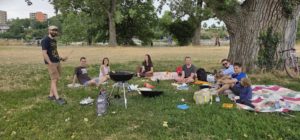Current News
December 2025
Dávid Starts in the Group
On the 1st, Dr. Dávid Hovančík started work as a post-doctoral researcher in our group. Dávid earned his Bachelors and Masters in Physical Engineering of Progressive Materials from the University of Presov in Slovakia in 2019 and 2021, respectively. He then moved to Charles Univeristy in Prague, earning a Ph.D. in Mathematics and Physics in 2025. There he worked as a experimental condensed matter physicist on magnetism and its interaction with light and lattice vibrations. In 2024, he won a Fullbright Fellowship and visited the group of Prof. Xiaodong Xu at the University of Washington, USA between 2024 and 2025. Welcome Dávid!
November 2025
Paper on Advanced SQUID-on-lever Published in PR Applied
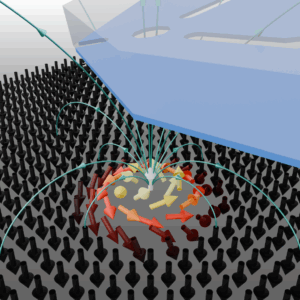 On the 14th, Physical Review Applied published our paper entitled, Advanced SQUID-on-lever scanning probe for high-sensitivity magnetic microscopy with sub-100-nm spatial resolution. Superconducting quantum interference devices (SQUIDs) are exceptionally sensitive magnetometers, capable of detecting weak magnetic fields. Miniaturizing these devices and integrating them onto scanning probes enables high-resolution imaging at low temperatures. In this work, we demonstrate the fabrication of nanometer-scale niobium SQUIDs with inner-loop sizes down to 10 nm at the apex of individual planar silicon cantilevers via a combination of wafer-scale optical lithography and focused ion beam (FIB) milling. These robust SQUID-on-lever probes overcome many of the limitations of existing devices, achieving spatial resolution better than 100 nm, magnetic flux sensitivity of 0.3 μΦ0/√Hz, and operation in magnetic fields up to about 0.5 T at 4.2K. Nanopatterning via Ne- or He-FIB milling allows for the incorporation of a modulation line for coupling magnetic flux into the SQUID or a third Josephson junction, for shifting its phase.
On the 14th, Physical Review Applied published our paper entitled, Advanced SQUID-on-lever scanning probe for high-sensitivity magnetic microscopy with sub-100-nm spatial resolution. Superconducting quantum interference devices (SQUIDs) are exceptionally sensitive magnetometers, capable of detecting weak magnetic fields. Miniaturizing these devices and integrating them onto scanning probes enables high-resolution imaging at low temperatures. In this work, we demonstrate the fabrication of nanometer-scale niobium SQUIDs with inner-loop sizes down to 10 nm at the apex of individual planar silicon cantilevers via a combination of wafer-scale optical lithography and focused ion beam (FIB) milling. These robust SQUID-on-lever probes overcome many of the limitations of existing devices, achieving spatial resolution better than 100 nm, magnetic flux sensitivity of 0.3 μΦ0/√Hz, and operation in magnetic fields up to about 0.5 T at 4.2K. Nanopatterning via Ne- or He-FIB milling allows for the incorporation of a modulation line for coupling magnetic flux into the SQUID or a third Josephson junction, for shifting its phase.
Such advanced functionality, combined with high spatial resolution, large magnetic field range, and the ease of use of a cantilever-based scanning probe, extends the applicability of scanning SQUID microscopy to a wide range of magnetic, normally conducting, superconducting, and quantum Hall systems. We demonstrate magnetic imaging of skyrmions at the surface of bulk Cu2OSeO3. Analysis of the point spread function determined from imaging a single skyrmion yields a full width at half maximum of 71 nm. Moreover, we image modulated magnetization patterns with a period of 65 nm.
The work was a close collaboration with the group of Prof. Dieter Kölle (Tübingen). Dr. Armin Knoll (IBM Zürich) and colleagues fabricated the custom designed cantilever probes, the Cu2OSeO3 crystal was provided by Dr. Arnaud Margez (EPFL) and colleagues, and the superconducting device layer was made by Dr. Oliver Kieler (PTB). In our own group, the work was led by recent Ph.D. graduate Dr. Daniel Jetter with contributions from Ph.D. student Katharina Kress, and post-doctoral researcher Dr. Andriani Vervelaki. Research scientist Dr. Boris Groß worked on the micromagnetic simulations. The work was made possible by our FET Open project FIBsuperProbes. Read more about it on the SNI news site.
Paper on Imaging Twisted van der Waals Antiferromagnet Published
On the 14th, ACS Nano published a paper entitled, Imaging magnetic switching in orthogonally twisted stacks of a van der Waals antiferromagnet, on which we collaborated. The article discusses experiments on orthogonally twisted stacks of the van der Waals antiferromagnet CrSBr, aiming to exploit an extreme misalignment of magnetic anisotropy across the twisted interface. Stacking van der Waals magnets holds promise for creating new hybrid materials with properties that do not exist in bulk materials. Using nitrogen-vacancy center microscopy, our collaborators constructed vector maps of the magnetization, and tracked their evolution under an external field, in a range of orthogonally twisted compensated and uncompensated configurations differing by the number of layers. They showed that twisted stacking consistently modifies the local magnetic switching behavior of constituent flakes, and that these modifications are spatially nonuniform.
Research scientist Dr. Boris Groß carried out the micromagnetic simulations used in the analysis of the experiments. The work was a collaboration with Prof. David Broadway (RMIT) and colleagues.
October 2025
EuraMet Project Review Meetings
This month, group members attended mid-term meetings for our two EuraMet projects, MetSuperQ and QuAHMET. Research scientist Dr. Floris Braakman, and Ph.D. students Loris Durante and Antonella Restino attended the MetSuperQ meeting in Gran Sasso, Italy from the 14th to the 17th. Floris, research scientist Dr. Paritosh Karnatak, post-doctoral researcher Dr. Damien Richert, and Prof. Poggio attended the QuAHMET meeting in Würzburg, Germany from the 29th to the 30th. Floris gave a talk during the meeting.
MetSuperQ aims to develop tools meant to address challenges in scaling up superconducting qubits. These new tools will underpin further engineering advances and allow for accurate characterization of qubits and materials, as well as manipulation and read-out. QuAHMET focuses is on the traceable measurement and characterization of quantum anomalous Hall effect materials as devices and primary resistance standard candidates. EuraMet (European Association of National Metrology Institutes) is a collaborative alliance of national metrological organizations from member states of the European Union and of the European Free Trade Association (EFTA) whose purpose is to achieve higher efficiency by co-ordinating and sharing metrological activities and services.
Lukas and Daniel Earn their Ph.D
On the 23rd, for the first time in group history, two doctoral students defended their thesis on the same day.
In the morning, Ph.D. student Lukas Schneider defended his thesis entitled, “Magnetic force microscopy with a nanowire cantilever”, earning his doctorate in physics summa cum laude. The defense was chaired by Prof. Richard Warburton with Prof. Arnaud Gloppe (Strasbourg), Prof. Ernst Meyer, and Prof. Poggio making up the committee of experts. Lukas earned his previous degrees from the University of Basel, working in our lab as a Masters student starting in September 2019. Congratulations Dr. Schneider!
In the afternoon, Ph.D. student Daniel Jetter defended his thesis entitled, “SQUID-on-cantilever: A hybrid scanning probe for magnetic nano-imaging”, earning his doctorate in physics magna cum laude. The defense was chaired by Prof. Tomasz Smolenski with Prof. Yonathan Anahory (Hebrew University) — via video link — Prof. Patrick Maletinsky, and Prof. Poggio making up the committee of experts. Daniel earned his previous degrees from the University of Tübingen and started working in our lab as a visiting Masters student in January 2020. Congratulations Dr. Jetter!
After the defenses, the two freshly baked doctors of philosophy jointly hosted a lively aperò with group members, friends, and family. Congratulations to all on the great success!
Yonathan Anahory Gives Colloquium
On the 17th, Prof. Yonathan Anahory (Hebrew University) visited our group and gave the department’s colloquium on Prof. Poggio’s invitation. His talk entitled, “Probing magnetic edge states by nanoscale magnetic imaging,” described his most recent experimental work on two-dimensional magnets. During the day, he visited our labs, discussed with group members, and met with members of other groups in the department.
Group Retreat and Workshop in Montafon
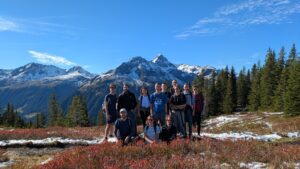 From the 7th to the 10th, 16 group members attended a retreat and workshop at the ‘Sportclub Klein Tirol’ in the alpine village of Vandans, Austria, in the Montafon region along the Swiss border. The get-together was a joint event with the groups of Dieter Kölle and Reinhold Kleiner from the Eberhard Karls University of Tübingen and funded by the Wilhelm and Else Heraeus Stiftung. A four-day program of talks and outdoor events promoted exchanges on superconducting devices, magnetism, force sensing, and opto-mechanics. Reinhold Kleiner gave an impromptu talk on the first evening about that day’s Nobel Prize in Physics and its recipients from the group of John Clarke (Berkeley), who was a post-doctoral advisor and collaborator of his and Dieter’s. Thanks to Susanne Maier for the excellent organization!
From the 7th to the 10th, 16 group members attended a retreat and workshop at the ‘Sportclub Klein Tirol’ in the alpine village of Vandans, Austria, in the Montafon region along the Swiss border. The get-together was a joint event with the groups of Dieter Kölle and Reinhold Kleiner from the Eberhard Karls University of Tübingen and funded by the Wilhelm and Else Heraeus Stiftung. A four-day program of talks and outdoor events promoted exchanges on superconducting devices, magnetism, force sensing, and opto-mechanics. Reinhold Kleiner gave an impromptu talk on the first evening about that day’s Nobel Prize in Physics and its recipients from the group of John Clarke (Berkeley), who was a post-doctoral advisor and collaborator of his and Dieter’s. Thanks to Susanne Maier for the excellent organization!
Paper on Magnetic Imaging of Annite Published
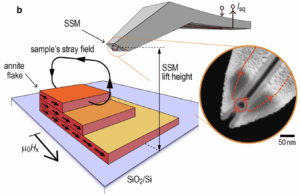 On the 2nd, Communications Materials published our paper entitled, Imaging magnetic order in a two-dimensional iron-rich phyllosilicate. Therein, we report on visualizing magnetic order in monolayers of annite, which is a fully air-stable layered magnetic mica. We used nanometer-scale scanning superconducting quantum interference device (SQUID) microscopy to directly observe domain formation in this representative of two-dimensional (2D) magnetic phyllosilicates. Because 2D magnetic micas are fully air-stable, have a large band-gap, and are high-k vdW insulators, they could be integrated into magnetoresistive tunnel junctions, magnetic random access memories, spin transistors, and nano-scale sensors. In addition, because many phyllosilicates are bio-compatible and bio-degradable, further understanding and engineering magnetism in this material class, especially at the 2D limit, could also open avenues in bio-technologies, including in targeted drug delivery and in-vivo sensing.
On the 2nd, Communications Materials published our paper entitled, Imaging magnetic order in a two-dimensional iron-rich phyllosilicate. Therein, we report on visualizing magnetic order in monolayers of annite, which is a fully air-stable layered magnetic mica. We used nanometer-scale scanning superconducting quantum interference device (SQUID) microscopy to directly observe domain formation in this representative of two-dimensional (2D) magnetic phyllosilicates. Because 2D magnetic micas are fully air-stable, have a large band-gap, and are high-k vdW insulators, they could be integrated into magnetoresistive tunnel junctions, magnetic random access memories, spin transistors, and nano-scale sensors. In addition, because many phyllosilicates are bio-compatible and bio-degradable, further understanding and engineering magnetism in this material class, especially at the 2D limit, could also open avenues in bio-technologies, including in targeted drug delivery and in-vivo sensing.
The work represents a collaboration with the group of Prof. Aleksandar Matković (Leoben, Austria) and his associates. From our group, Ph.D. students Andriani Vervelaki and Daniel Jetter as well as post-doctoral researcher Dr. Kousik Bagani performed the scanning SQUID microscopy and collected the data. Kousik initiated the collaboration and Prof. Poggio supervised the work in Basel.
September 2025
SNI Annual Meeting
From the 10th to the 12th, Ph.D. students Lukas Schneider and Luca Forrer along with Prof. Poggio attended the Swiss Nanoscience Institute’s Annual Meeting on the Lake of Hallwil in the Canton Aargau. Lukas and Luca both presented posters on their work and Prof. Poggio hosted the proceedings as SNI Director.
Katharina Speaks in Zürich
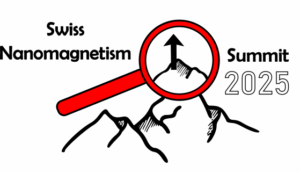 On afternoon of the 9th, Ph.D. student Katharina Kress gave a talk at the Swiss Nanomagnetism Summit in Zürich, Switzerland. The workshop brought together researchers from Switzerland and abroad working on predicting, creating, and measuring novel functionalities in spintronic and nanomagnetic systems. This two-day event, on Monday the 8th and Tuesday the 9th, took place on the campus of ETH Zürich. Katharina’s talk was entitled, “Imaging the magnetic order in a ferromagnetic monolayer”.
On afternoon of the 9th, Ph.D. student Katharina Kress gave a talk at the Swiss Nanomagnetism Summit in Zürich, Switzerland. The workshop brought together researchers from Switzerland and abroad working on predicting, creating, and measuring novel functionalities in spintronic and nanomagnetic systems. This two-day event, on Monday the 8th and Tuesday the 9th, took place on the campus of ETH Zürich. Katharina’s talk was entitled, “Imaging the magnetic order in a ferromagnetic monolayer”.
Rounak Starts as Post-doc
On the 1st, Dr. Rounak Jha started as a post-doctoral researcher in the group. Rounak earned his Bachelors and Masters in Physics from the Indian Institute of Science Education and Research Pune in 2021. He then came to Switzerland to do his Ph.D. in Physics at the École Polytechnique Fédérale de Lausanne (EPFL) supervised by Prof. Mitali Banerjee from EPFL and Prof. Christian Schönenberger from Basel. He earned his degree in the summer of 2025. Welcome Rounak!
August 2025
Rooftop BBQ with the Machine Shop
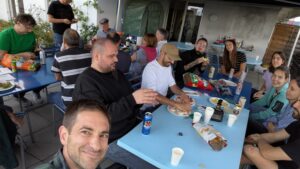 On Friday the 29th, we had our annual barbecue on the derpartment’s roof-top with our colleagues from the Machine Shop, Electronics Shop, and administrative staff, as well as with alumni and friends. Despite some scattered rain, a good time was had by all. Fomer administrative staff Audrey Fischer and Barbara Kammermann joined us, as well as former group members Denis Vasyukov, David Jaeger, Giulio Romagnoli, Hinrich Mattiat, and a few new members of the extended family. Thanks to all who helped organize and see you next year!
On Friday the 29th, we had our annual barbecue on the derpartment’s roof-top with our colleagues from the Machine Shop, Electronics Shop, and administrative staff, as well as with alumni and friends. Despite some scattered rain, a good time was had by all. Fomer administrative staff Audrey Fischer and Barbara Kammermann joined us, as well as former group members Denis Vasyukov, David Jaeger, Giulio Romagnoli, Hinrich Mattiat, and a few new members of the extended family. Thanks to all who helped organize and see you next year!
Lorena Wins Prestigious Fellowship
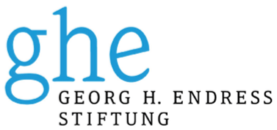 On the 22nd, it was announced that post-doctoral researcher Dr. Lorena Niggli won a prestigious Georg H. Endress Fellowship for outstanding young scientists working as post-doctoral researchers in the Physics Departments of the University of Basel and University of Freiburg, Germany. Lorena and 3 other fellows were selected from a pool of over 60 applicants.
On the 22nd, it was announced that post-doctoral researcher Dr. Lorena Niggli won a prestigious Georg H. Endress Fellowship for outstanding young scientists working as post-doctoral researchers in the Physics Departments of the University of Basel and University of Freiburg, Germany. Lorena and 3 other fellows were selected from a pool of over 60 applicants.
The Georg H. Endress Postdoc Cluster is a cross-border collaboration between the University of Basel and the Albert-Ludwigs University in Freiburg, Germany. This initiative is designed to promote and train outstanding young scientists in the rapidly developing field of quantum science. It aims to attract outstanding and highly motivated early-career scientists to participate in cutting-edge projects within research groups in Basel and Freiburg. Target areas of the Cluster include quantum computation, simulation, sensing and metrology, quantum technologies, complex quantum systems, quantum materials, and other emerging topics in quantum science.
Congratulations Lorena!
Paritosh Organizes Graphene Workshop
The 9th Graphene Workshop has held in Basel from the 20th to the 22nd. Research scientist Dr. Paritosh Karnatak was one of two organizers of the event, which focussed on transport, optics and magnetism in van der Waals materials and their heterostructures, including moiré materials. Topics presented included correlated phases, superconductivity, topological phenomena, electron interferometry, and heterobilayers.
On the afternoon of Thursday the 21st, Ph.D. student Katharina Kress gave a talk entitled, “Imaging the magnetic order in a ferromagnetic monolayer”.
Lorena Joins Group
On the 4th, Dr. Lorena Niggli started work as a post-doctoral researcher in the group. Lorena earned her Bachelors and Masters in Physics from the University of Zürich in 2019 and 2021, respectively. She then moved to Radboud Univeristy in Nijmegen, the Netherlands and recently earned her Ph.D. in Condensed Matter Physics there. During her time in the Netherlands, Lorena focused on the magnetism of spin glasses and its aging dynamics as observed with spin-polarized scanning tunneling microscopy. Welcome Lorena!
Low-temperature Conference in Helsinki
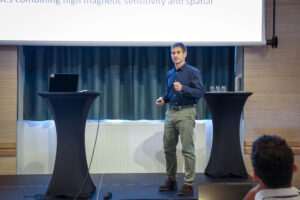 From the 3rd to the 6th, Prof. Poggio attended the Low-Temperature Quantum Detectors: from fundamentals to applications conference in Helsinki, Finland. On the 6th, he gave an invited talk entitled, “Imaging vdW magnets and magnetic devices in the 2D limit”.
From the 3rd to the 6th, Prof. Poggio attended the Low-Temperature Quantum Detectors: from fundamentals to applications conference in Helsinki, Finland. On the 6th, he gave an invited talk entitled, “Imaging vdW magnets and magnetic devices in the 2D limit”.
July 2025
June 2025
Spin Dynamics GRC in Les Diablerets
From the 29th to July 3rd, Prof. Poggio attended the Spin Dynamics in Nanostructures Gordon Research Conference in Les Diablerets, Switzerland. The workshop was dedicated to the most recent and counter-intuitive examples of magnetism and spin dynamics, as well as to applications of fundamental research to data storage, memory, and computing hardware. Prof. Poggio gave an invited talk on the evening of the 29th entitled, “Nanoscale scanning probe microscopy of 2D magnetism”.
Group Members at SPIN Annual Meeting
From the 18th to the 20th, Ph.D. students Luca Forrer, Aurèle Kamber, Daniel Jetter, and research scientist Dr. Floris Braakman attended the 5th Annual Meeting of the NCCR SPIN in Pontresina, Switzerland. Luca and Aurèle presented a poster entitled, “Scanning nanowire quantum dot” on the evenings of the 18th and 19th. On the afternoon of the 18th, Daniel gave an ‘innovation pitch’.
Group Members at Spin Phenomena Workshop
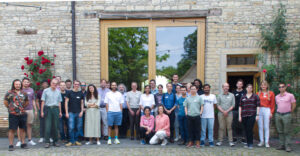 From the 17th to the 19th, research scientist Dr. Paritosh Karnatak and Prof. Poggio attended the Quantum Functionalities of Nanomagnets workshop in Ingelheim, Germany. The workshop aimed to discuss the quantum aspects of tailored magnetic platforms, whose main advantage lies in the high degree of control in manipulation, preparation, parameter tunability, and all-magnetic device integration. Paritosh presented a poster and Prof. Poggio gave a tutorial talk on the afternoon of the 17th entitled, “Magnetic imaging on the nanometer scale” (link to video).
From the 17th to the 19th, research scientist Dr. Paritosh Karnatak and Prof. Poggio attended the Quantum Functionalities of Nanomagnets workshop in Ingelheim, Germany. The workshop aimed to discuss the quantum aspects of tailored magnetic platforms, whose main advantage lies in the high degree of control in manipulation, preparation, parameter tunability, and all-magnetic device integration. Paritosh presented a poster and Prof. Poggio gave a tutorial talk on the afternoon of the 17th entitled, “Magnetic imaging on the nanometer scale” (link to video).
Prof. Poggio in Hamburg
Prof. Poggio traveled to Hamburg, Germany on the invitation of Prof. Philip Moll of the Max Planck Institute for the Structure and Dynamics of Matter to give the “Hamburg Photon Science Colloquium” on the afternoon of the 6th. The colloquium series is jointly organized by all photon science organizations and research cooperations on the Campus Bahrenfeld. Prof. Poggio gave a talk entitled, “Imaging vdW magnets and magnetic devices in the 2D limit”.
May 2025
Estefani Leaves to Take Independent Scientist Position at CBPF
 The 31st was Dr. Estefani Marchiori’s last day as a post-doctoral researcher in our group. Estefani started work in the lab back in July 2019 after earning her Ph.D. from the University of Bath studying the interplay between ferromagnetism and superconductivity using scanning Hall microscopy under Prof. Simon Bending. Upon starting in Basel, she led our efforts imaging both superconductivity and magnetism using scanning SQUID-on-tip sensors. During this time, she also helped develop a new, more convenient, more robust, and more flexible method for fabricating SQUID-on-tip sensors.
The 31st was Dr. Estefani Marchiori’s last day as a post-doctoral researcher in our group. Estefani started work in the lab back in July 2019 after earning her Ph.D. from the University of Bath studying the interplay between ferromagnetism and superconductivity using scanning Hall microscopy under Prof. Simon Bending. Upon starting in Basel, she led our efforts imaging both superconductivity and magnetism using scanning SQUID-on-tip sensors. During this time, she also helped develop a new, more convenient, more robust, and more flexible method for fabricating SQUID-on-tip sensors.
Estefani is now moving on to start a new adventure as an independent scientist at the Centro Brasileiro de Pesquisas Físicas (CBPF) in Rio de Janeiro, Brazil. Thank you for everything, good luck, and we look forward to work together in the future!
Paper on Imaging of Ferromagnetic Superconductor Appears
 On the 31st, Communications Materials published our paper written in collaboration with Prof. Simon Bending and Dr. Joe Wilcox from the University of Bath on imaging vortex dynamics in a ferromagnetic superconductor. The paper entitled, Magnetically controlled vortex dynamics in a ferromagnetic superconductor, presents measurements of EuFe2(As1-xPx)2, a superconductor with a maximum critical temperature of 25 K that exhibits full coexistence with ferromagnetic order below 19 K. The interplay between superconductivity and ferromagnetism in this material leads to narrowing of ferromagnetic domains at higher temperatures and spontaneous nucleation of vortices and antivortices at lower temperatures. In the paper, we demonstrate how the underlying magnetic structure controls the superconducting vortex dynamics in applied magnetic fields. Just below the ferromagnetic ordering temperature we observe a pronounced peak in the creep activation energy, and magnetic force microscopy measurements reveal the presence of very closely spaced vortex clusters. We attribute these observations to the formation of vortex polarons, for which we present a theoretical description. In contrast, we link strong magnetic irreversibility at low temperatures to a critical current governed by giant flux creep over an activation barrier for vortex-antivortex annihilation near domain walls. The work suggests new routes for the magnetic enhancement of vortex pinning with important applications in high-current conductors.
On the 31st, Communications Materials published our paper written in collaboration with Prof. Simon Bending and Dr. Joe Wilcox from the University of Bath on imaging vortex dynamics in a ferromagnetic superconductor. The paper entitled, Magnetically controlled vortex dynamics in a ferromagnetic superconductor, presents measurements of EuFe2(As1-xPx)2, a superconductor with a maximum critical temperature of 25 K that exhibits full coexistence with ferromagnetic order below 19 K. The interplay between superconductivity and ferromagnetism in this material leads to narrowing of ferromagnetic domains at higher temperatures and spontaneous nucleation of vortices and antivortices at lower temperatures. In the paper, we demonstrate how the underlying magnetic structure controls the superconducting vortex dynamics in applied magnetic fields. Just below the ferromagnetic ordering temperature we observe a pronounced peak in the creep activation energy, and magnetic force microscopy measurements reveal the presence of very closely spaced vortex clusters. We attribute these observations to the formation of vortex polarons, for which we present a theoretical description. In contrast, we link strong magnetic irreversibility at low temperatures to a critical current governed by giant flux creep over an activation barrier for vortex-antivortex annihilation near domain walls. The work suggests new routes for the magnetic enhancement of vortex pinning with important applications in high-current conductors.
The magnetic force microscopy experiments using ultrasenstive nanowire-based probes were carried out in our Basel lab by Ph.D. student Lukas Schneider and post-doctoral researcher Dr. Estefani Marchiori. Collaborators from the group of Prof. Raffi Budakian grew the Si nanowires that were functionalized with magnetic tips via focused-electron-beam-induced deposition in Basel. Dr. Marchiori led the Basel part of the work and Dr. Wilcox and Prof. Bending initiated and coordinated the overall collaboration, which included sample growth from the University of Tokyo, theoretical work from the University of Bordeaux, and magnetometry measurments in Bath and at the University of Bristol.
Prof. Poggio at Summer School in Lecce
On the 30th Prof. Poggio gave a talk at the Quantum Optics and Quantum Materials summer school in Lecce, Italy. The school took place from the 26th to the 30th and was aimed at Ph.D. students and post-doctoral researchers in the fields of quantum technology, quantum optics, many-body physics, quantum materials, quantum information, quantum magnetism, spintronics, and superconductivity. Prof. Poggio gave the last talk, which was entitled, “Imaging quantum magnetism.”
Loris at School in Benasque
From the 21st to 30th, Ph.D. student Loris Durante attended the Spring School on Superconducting Qubit Technology in Benasque, Spain. The school aimed to cover a broad range among those subjects needed for a quantum physicist or engineer to work with superconducting devices. Expert speakers from universities, research institutes, and companies, were invited to cover not only the basics but also the specific techniques required to design, fabricate, and operate quantum devices based on superconducting circuits. Loris presented a poster on the 22nd entitled, “Scanning SQUID Microscopy with Nanometer Spatial Resolution of Superconducting Materials Using SQUID-on-Tip and -Lever.”
Group Members in Grenoble
From the 20th to the 23rd, research scientists Dr. Floris Braakman and Dr. Paritosh Karnatak attended the Quantum Matter International Conference (QUANTUMatter 2025) in Grenoble, France. The conference aimed at gathering the various communities engaged in the science and technologies of quantum information and quantum matter, to foster the incubation of new ideas and collaborations at the forefront of quantum technologies, emerging quantum materials, and novel generations of quantum communication protocols, quantum sensing and quantum simulation. Paritosh gave a talk on the 21st entitled, “Probing the magnetic order in a ferromagnetic monolayer”.
Jiří Pospíšil Visits the Group
On the 12th and 13th, Dr. Jiří Pospíšil from Charles University in Prague visited our group. He gave a talk at our department’s Quantum and Nano Seminar on the afternoon of the 12th entitled, “Peculiar properties of van der Walls ferromagnet VI3“.
Andriani Earns Ph.D. and Marco Gibertini Visits
On the 5th, Ph.D. student Andriani Vervelaki defended her thesis entitled, “Probing 2D magnetism using scanning SQUID microscopy”, earning her doctorate in physics summa cum laude. The defense was chaired by Prof. Patrick Maletinsky with Prof. Marco Gibertini (Modena), Prof. Semonti Bhattacharyya (Leiden) — joining via video link — Prof. Ilaria Zardo, and Prof. Poggio making up the committee of experts. Andriani joined the lab in November of 2020 after receiving her Bachelor and Masters of Science in 2018 and 2020, respectively, both from Crete University. Contgralations to Dr. Vervelaki!
Our external expert, Prof. Marco Gibertini visited the lab and department on the 5th and 6th. On the afternoon of the 5th, he gave the Nano & Quantum Seminar with a talk entitled, “Engineering emergent topological phases in van der Waals heterostructures”.
April 2025
Karting with the Machine Shop
On the 29th, 11 group members and 3 members of our Physics Department Machine Shop drove out to the Sundgau Karting Track in the fields of nearby Steinsoultz, France. Everyone enjoyed 3 sessions of speeding around the 1.25-km track at an average of around 60 km/h. Thanks to all for a good time and see you next time! Pics here.
Quantum needs Nano
On the 14th, the Swiss Nanoscience Institute (SNI) marked ‘World Quantum Day’ by publishing a video with researchers from the Department of Physics at the Univeristy of Basel sharing insights into their work in quantum science. In the video, they explain the areas of quantum science in which they work and why this research would not be possible without nanoscience and nanotechnology.
Antonella in Capri
From the 6th to the 13th, Ph.D student Antonella Restino attended the 19th Capri Spring School on Transport in Nanostructures. The school addressed Novel aspects of superconducting devices and took place on the island of Capri, Italy. Antonella presented a poster on the 10th entitled, “Scanning SQUID imaging of superconducting circuits”.
Katharina Starts her Ph.D.
On the 1st, Katharina Kress started her Ph.D. in our group. Katharina received her Bachelor of Science in Physics in 2022 from the University of Basel. After completing a Master project in our group in February of 2024, she decided to pursue her Masters thesis with us starting the following March. She worked on designing and fabricating Nb 3-junction SQUIDs on planar cantilevers and characterizing them as scanning probes. After writing an excellent thesis and defending it in January of 2025, she decided to pursue her Ph.D. in our group. Welcome!
March 2025
End of FIBsuperProbes
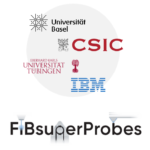 After four and a half years, on the 31st, our consortium FIBsuperProbes officially came to and end. As a European Union-funded Horizon 2020 research project, it focused on developing nanometer-scale superconducting quantum interference devices (SQUIDs) on cantilever scanning probes. To accomplish this task, researchers in the consortium used focused-ion-beam (FIB) techniques, producing sensors with unprecedented size, functionality, and sensitivity, directly on custom-designed cantilevers. The scanning probes developed during the project hold immense potential for scanning applications such as high-resolution imaging of stray magnetic fields in van-der-Waals 2D magnets. Use of these probes in various research groups and even their commercialization is on-going.
After four and a half years, on the 31st, our consortium FIBsuperProbes officially came to and end. As a European Union-funded Horizon 2020 research project, it focused on developing nanometer-scale superconducting quantum interference devices (SQUIDs) on cantilever scanning probes. To accomplish this task, researchers in the consortium used focused-ion-beam (FIB) techniques, producing sensors with unprecedented size, functionality, and sensitivity, directly on custom-designed cantilevers. The scanning probes developed during the project hold immense potential for scanning applications such as high-resolution imaging of stray magnetic fields in van-der-Waals 2D magnets. Use of these probes in various research groups and even their commercialization is on-going.
Thanks to all the students, post-docs, technicians, and scientists involved in the project over the years. The collaboration between the groups of Dr. Armin Knoll (IBM Research Zürich), Prof. Jose Maria De Teresa (CSIC Zaragoza), Prof. Dieter Kölle (University of Tübingen), and our own group in Basel was both a pleasure and a great success. We look forward to working together soon in follow-up projects!
Thanks also, of course, to the European Union for the funding and our host institutions for providing the necessary support.
Final FIBsuperProbes Workshop
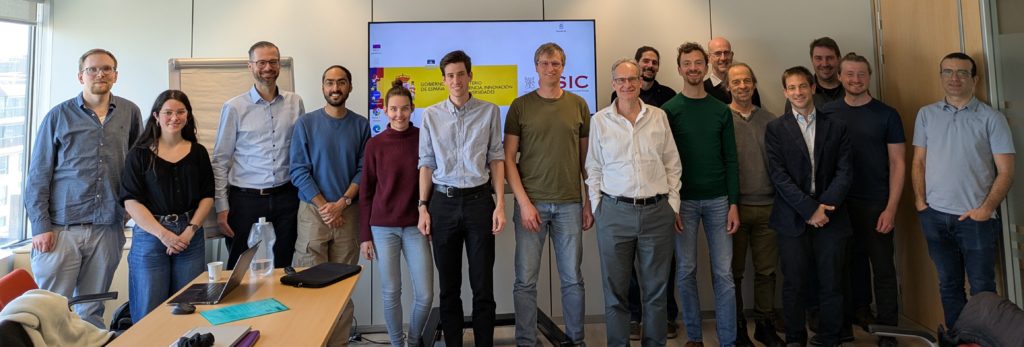 On the 25th and 26th, the FIBsuperProbes consortium, which we coordinate, came together for a vibrant and productive workshop at the CSIC office in Brussels. Over two days, researchers, collaborators, and industry representatives shared their latest progress on SQUID-on-cantilever devices and explored exciting applications in high-resolution magnetic imaging. The event featured engaging talks, insightful discussions, and valuable networking opportunities. We were especially pleased to welcome external guests from companies working in areas such as thin film technology and AFM cantilever fabrication, whose perspectives added depth to the conversations. A program can be found here.
On the 25th and 26th, the FIBsuperProbes consortium, which we coordinate, came together for a vibrant and productive workshop at the CSIC office in Brussels. Over two days, researchers, collaborators, and industry representatives shared their latest progress on SQUID-on-cantilever devices and explored exciting applications in high-resolution magnetic imaging. The event featured engaging talks, insightful discussions, and valuable networking opportunities. We were especially pleased to welcome external guests from companies working in areas such as thin film technology and AFM cantilever fabrication, whose perspectives added depth to the conversations. A program can be found here.
Thank you to all participants for their contributions and to Research Scientist Dr. Boris Groß, who organized the very successful event.
New Cryostat Installed
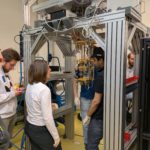 The week of the 17th, group members and a technician from the company BlueFors installed a new LD400 cryostat in the lab. The successful installation opens new possibilites for experiments at extremely low temperatures, down to 10 mK. Thanks especially to the Swiss National Science Foundation, the Swiss Nanoscience Institute, and the University of Basel for funding this important piece of equipment. Thanks also to Research Scientist Dr. Floris Braakman, who led the efforts to win funding, dealt with the design and purchase, and coordinated the installation.
The week of the 17th, group members and a technician from the company BlueFors installed a new LD400 cryostat in the lab. The successful installation opens new possibilites for experiments at extremely low temperatures, down to 10 mK. Thanks especially to the Swiss National Science Foundation, the Swiss Nanoscience Institute, and the University of Basel for funding this important piece of equipment. Thanks also to Research Scientist Dr. Floris Braakman, who led the efforts to win funding, dealt with the design and purchase, and coordinated the installation.
February 2025
News & Views by Paritosh in Nature
On the 5th, a News & Views article by research scientist Dr. Paritosh Karnatak and emeritus Prof. Christian Schönenberger entitled, ‘Unconventional’ superconductivity probed in twisted graphene, appeared in Nature. The piece highlights two research articles reporting on measurements of kinetic inductance in twisted bilayer and trilayer graphene, respectively.
January 2025
Nano Letters publishes paper on micromagnets for spin qubits
 On the 22nd, Nano Letters published our paper entitled, Simulation and measurement of stray fields for the manipulation of spin qubits in one- and two-dimensional arrays. By means of micromagnetic simulations and scanning superconducting quantum interference device (SQUID) microscopy (SSM), we show that the polycrystallinity of the magnet and nonuniform magnetization significantly impact the stray field and corresponding qubit properties. The random orientation of the crystal axis in polycrystalline Co magnets alters the qubit frequencies by up to 0.5 GHz, compromising single qubit addressability and single gate fidelities. We map the stray field of Fe micromagnets with an applied magnetic field of up to 500 mT, finding field gradients above 1 mT/nm. The measured gradients and the lower magnetocrystalline anisotropy of Fe demonstrate the advantage of using Fe instead of Co as magnets in spin qubit devices. These properties of Fe also enabled us to design a 2D arrangement of nanomagnets for driving spin qubits distributed on a 2D lattice.
On the 22nd, Nano Letters published our paper entitled, Simulation and measurement of stray fields for the manipulation of spin qubits in one- and two-dimensional arrays. By means of micromagnetic simulations and scanning superconducting quantum interference device (SQUID) microscopy (SSM), we show that the polycrystallinity of the magnet and nonuniform magnetization significantly impact the stray field and corresponding qubit properties. The random orientation of the crystal axis in polycrystalline Co magnets alters the qubit frequencies by up to 0.5 GHz, compromising single qubit addressability and single gate fidelities. We map the stray field of Fe micromagnets with an applied magnetic field of up to 500 mT, finding field gradients above 1 mT/nm. The measured gradients and the lower magnetocrystalline anisotropy of Fe demonstrate the advantage of using Fe instead of Co as magnets in spin qubit devices. These properties of Fe also enabled us to design a 2D arrangement of nanomagnets for driving spin qubits distributed on a 2D lattice.
The work represents a collaboration between our group and researchers at IBM Research Zürich. Ph.D. student Michele Aldeghi led the work and carried out the simulations and fabricated the samples under the supervision of Dr. Gian Salis and Dr. Rolf Allenspach at IBM. Our part of the study involved imaging the magnetic stray fields of the micromagnets via SSM. Ph.D. students Andriani Vervelaki and Daniel Jetter and former post-doctoral researcher Dr. Kousik Bagani carried out the work and analyzed the data with support from research scientist Dr. Floris Braakman. This included fabricating SQUID-on-lever probes, running low-temperature scanning probe measurements, and interpreting the data in the unusual regime of very high stray field.
Loris Starts as Ph.D.
On the 6th, Loris Durante started work as a Ph.D. student in the group. Loris received his Bachelor of Science in 2022 and his Master of Science in 2024 both in Physics from the University of Basel. He carried out both his Master project and thesis in our group on the fabrication, characterization, and optimization of SQUID-on-tip sensors for operation below 1 K. After successfully defending his work, he decided to join the group as a Ph.D. student. Welcome!

